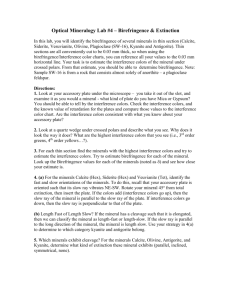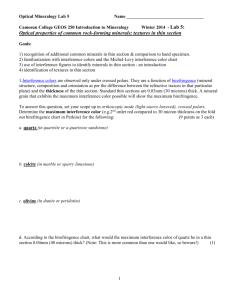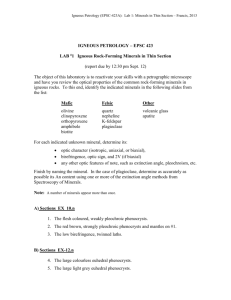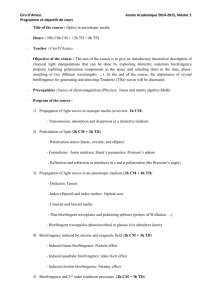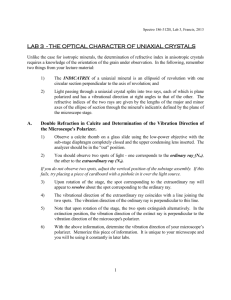Isotropic and anisotropic minerals
advertisement
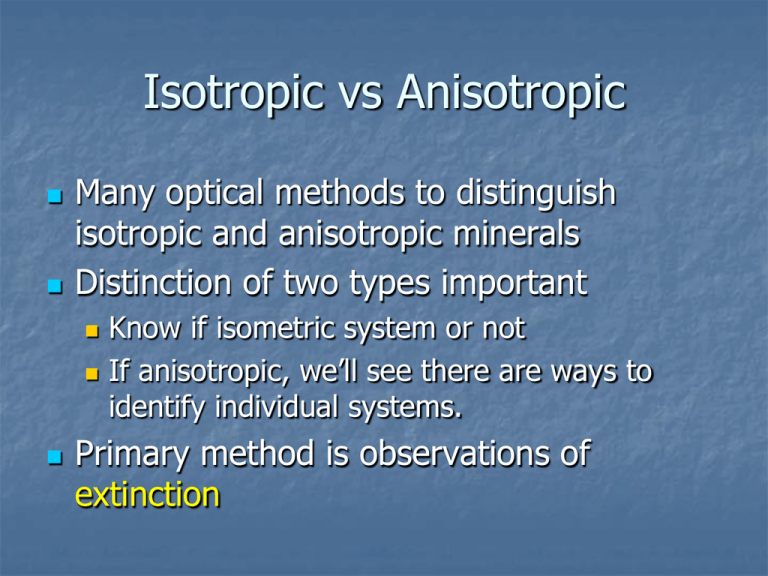
Isotropic vs Anisotropic Many optical methods to distinguish isotropic and anisotropic minerals Distinction of two types important Know if isometric system or not If anisotropic, we’ll see there are ways to identify individual systems. Primary method is observations of extinction Polarizing Microscope Ocular Analyzer, upper polarizer, nicols lens Objective Polarizer, typically oriented N-S Not Extinct Quartz crystals in plane polarized light Extinct Same quartz crystals with analyzer inserted (cross polarizers aka crossed nicols) One grain Individual crystals Feldspar partially extinct, Extinction in muscovite Extinction in calcite Isotropic Minerals Easily identified Always extinct with upper polarizer inserted That is no light passes the upper analyzer Rotate stage and remains extinct Vibration direction not changed by material All light blocked by upper polarizer Polarizing Microscope Ocular Analyzer, upper polarizer, nicols lens Objective Polarizer, typically oriented N-S Anisotropic Minerals Variable values of n within mineral Has property of double refraction Light entering material usually split into two rays Two rays vibrate perpendicular to each other Caveat: Special section of minerals: light not split and behaves like isotropic mineral – called optic axis All other orientations: light splits into two rays Optic axis Special direction where rays not split into two rays Wave normal and ray path coincide Hexagonal and tetragonal have one optic axis Uniaxial Orthorhombic, monoclinic, and triclinic have two optic axes Biaxial So… light usually split into two rays For each of the two light rays: Value of n is determined by vibration direction In one direction, the value of n is larger than the other Direction with large N is slow ray Direction with small n is fast ray Different values of n mean different angles of refraction – “double refraction” Interference Phenomena For most cuts of anisotropic minerals, light not completely blocked by analyzer Specific color is interference color Caused by two rays resolving to one ray when they leave the mineral Interference Colors Not true colors Viewed in crossed nicols (upper polarizer inserted) “Intermediate” interference colors “Low interference colors” Colored minerals Viewed in plane polarized light Biotite, a pleochroic mineral, natural color Cross nicols Muscovite showing interference colors YouTube video of pleochroism and interference colors Glaucophane – an amphibole: Na2Mg3Al2Si8O22 (OH) 2 Interference with monochromatic light Monochromatic = one wavelength Light split into fast and slow ray Fast ray travels farther than slow ray in same time Difference in the distances called retardation, D Retardation remains same after two rays leave mineral (air is isotropic) Note: here you need to imagine the two rays follow the same path even though they are refracted D = extra distance fast ray traveled Distance for slow ray d = thickness (distance) Typically 30 µm Distance for fast ray f = v/l; f constant so l changes Fig. 7-14 Retardation and Birefringence Derive definition of retardation Retardation controlled by two things: Thickness of mineral, d Difference in speed of fast and slow ray – (ns – nf) – must be positive number Units have to be length, typically reported as nm Birefringence Birefringence is the difference between ns and nf d = (ns – nf) Note: here you need to imagine the two rays follow the same path even though they are refracted D = extra distance fast ray traveled Distance for slow ray d = thickness (distance) Typically 30 µm Distance for fast ray f = v/l; f constant so l changes Fig. 7-14 Origin of interference colors Still talking about monochromatic light If retardation is an integer number of wavelengths: Components resolve into vibration direction same as original direction All light is blocked by analyzer Original polarized direction Resolved vibration direction – Identical to original direction D = 1,2,3… l Privileged direction of analyzer All light blocked = extinct Resolved vibration direction Fig. 7-15a If retardation is half integer of wavelength Components resolve into vibration direction 90º to original Light passes through analyzer Original polarized direction Resolved vibration directions 90º to original direction Privileged direction of analyzer D = ½, 3/2, 5/2… l All light passes Fig. 7-15b Fig. 7-4 bloss 1½ l 1l 2l 2l A more realistic depiction Note – this is still monochromatic light From Bloss, 1961 Interference with polychromatic light Polychromatic light All wavelengths Some l = integer value of D Most l ≠ integer value of D Interference colors depend on what wavelengths are allowed to pass through analyzer The wavelengths depend on retardation (D = d*d) Depending on magnitude of birefringence: If a narrow band of wavelengths passes through analyzer, see only one color Sometimes multiple l pass through analyzer, see white For standard thin section (d=30µm) Interference colors are: Red Quartz: D = 250 nm 1st order white Kyanite: D = 500 nm; 1st order red Calcite: D = 2500 nm; 4th order white; cream Red 2500/625= 4 750/500 = 1.5 (half integer) 750 l passes through Green 2500/500 = 5 500/500 = 1 Blue is blocked Indigo 2500/416.6 = 6 Violet Visible l All pass through 416.6, 500, 625 l = full integer, blocked – combined to make white Fig. 7-17 Interference Colors Not true colors Viewed in crossed nicols (upper polarizer inserted) “2nd – 3rd order reds and blues” “1st order gray” Color chart Shows range of interference colors depends on retardation Plot of d (thickness of thin section) versus D (retardation) Diagonal lines are birefringence, d = ns - nf Color chart Divided into orders Orders are in multiples of 550 nm Successively higher orders are increasingly washed out Above 4th order, color becomes creamy white Retardation D (nm) Color chart Two Primary uses: Determine birefringence of mineral Determine thickness of thin sections Recall retardation controlled by thickness and birefringence; D = dd Retardation is simply the observed interference color, D E.g., the sum of wavelengths that are half integers of retardation. Determining thickness of thin section Use quartz (or other easily identifiable, common mineral) Maximum d is 0.009 From back of book: ns = 1.553; nf = 1.544 Actual birefringence depends on orientation of grain Page 232 Maximum birefringence & retardation when c axis is parallel to stage Birefringence & retardation = 0 when c axis is perpendicular to stage (optic axis) Intermediate birefringence & retardation for intermediate orientation Procedure Find quartz with highest birefringence (correct cut of mineral) 1. 1. 2. 3. 4. Done by scanning many quartz crystals Find where the retardation (given by color), intersects lines for birefringence Calculate it from formula for birefringence: d=D/d Or read off thickness from chart Fig.7-18 Typical slide thickness is 30 µm (0.03 mm) Quartz will be first order white to yellow Thin sections may not be perfect Variable thicknesses Thin on edges Thick sections – 70 µm Used for inclusions Freeze/thaw of fluid inclusions Determining birefringence Maximum d is a useful diagnostic value Gives the nmaximum and nmiminum of grain Easily determined in thin section with known thickness Distribution of birefringence: Some with zero d Some with maximum d Most with intermediate d Procedure for determining birefringence 1. 2. 3. 4. Find grain with highest interference colors – most likely to have fastest and slowest n values Find retardation on the basis of the color (bottom of chart) Calculate the birefringence using equation: d=D/d Or find maximum birefringence from chart Fig. 7-18b Extinction Many grains in a thin section go dark (extinct) every 90º of rotation Cause for extinction is orientation of vibration directions Occurs when principle vibration directions are parallel to vibration directions of upper and lower polarizers Light retains original polarized direction Light blocked by analyzer Extinction Ocular Analyzer, upper polarizer, nicols lens Polarizer, typically oriented N-S Extinct Birefringent Fig 7-19 Importance of extinction Allows determination of principle vibration directions When extinct, the orientation of the principle vibration directions are N-S and E-W Extinction in muscovite Extinction in calcite Accessory Plates Primary functions: Determine optic sign Determine sign of elongation Microscopy Ocular Analyzer, upper polarizer, nicols lens Accessory Slot Polarizer, typically oriented N-S Construction: Usually gypsum - full wave plate, D = 550 nm Common mica - ½ wave plate, D = 150 nm Retardation is known Orientation of principle vibration directions is known, set at 45º to polarizer and analyzer Fast ray is length of holder, slow ray is perpendicular to holder Interference of accessory plate either adds or subtracts from retardation of mineral With slow ray of mineral parallel slow ray of accessory plate – retardation increases With slow ray of mineral parallel fast ray of accessory plate – retardation decreases Net result: Accessory plate tells you orientation of fast and slow direction in mineral Important for many optical observations D mineral D Total – greater than before – slow on slow addition D Total – less than before – slow on fast subtraction D mineral D total Fig. 7-20 Procedure to determine fast and slow 1. 2. 3. 4. 5. Rotate grain to extinction – either fast or slow ray parallel to polarized light direction Rotate stage 45º Note interference color Insert accessory plate Observe if color increases or decreases (right or left on chart) Interference plate will also determine order of interference color (1) extinction (3) Insert accessory plate If colors increase after insertion – slow on slow (2) Rotate 45º Fig. 7-21
